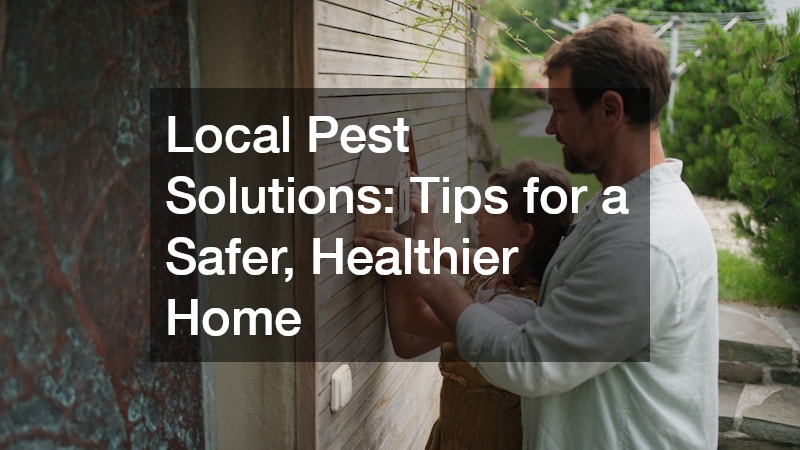Maintaining a clean, safe, and pest-free home is a challenge many homeowners face, and having access to effective local pest solutions can make all the difference. Pests are not just an annoyance; they pose significant health risks, can damage property, and interfere with daily life. From ants and roaches to rodents and other critters, understanding the behavior and habits of pests is crucial for keeping your home safe.
A local pest control company can help, but homeowners also benefit from taking proactive steps on their own. This includes implementing preventive measures, exploring natural remedies, and knowing when professional intervention is necessary. Additionally, certain home improvements, such as working with window contractors or utilizing window treatment services, can indirectly reduce pest activity by improving insulation and minimizing entry points. Home construction practices, garage doors, and log home maintenance all play a role in creating an environment less hospitable to pests. Even seemingly unrelated services like pet boarding require attention to pest control, since pets can carry or attract pests into a household.
This article provides a comprehensive guide to the most effective strategies for pest prevention and removal, blending practical advice with insights into professional services. By the end, homeowners will have a clear understanding of how to protect their homes while promoting a safer, healthier living environment using trusted local pest solutions.
What Are the Most Common Household Pests?
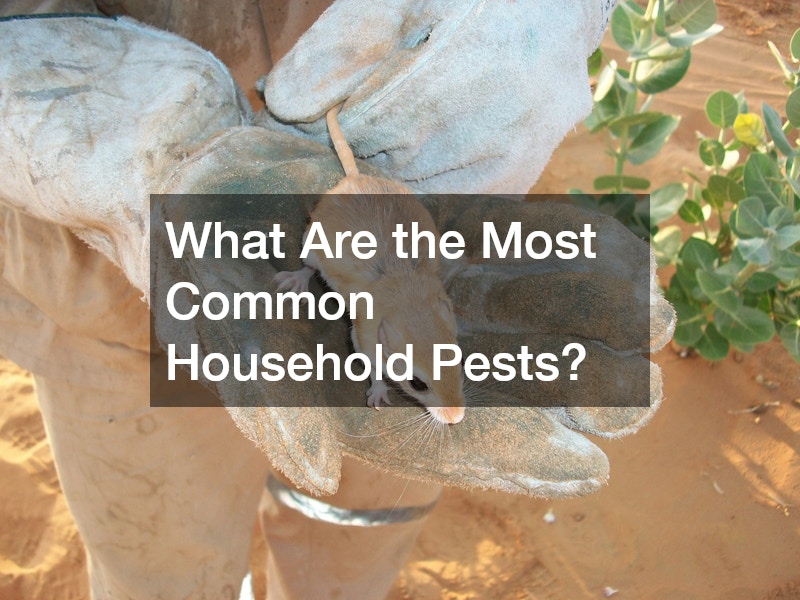
Identification of Common Pests
Understanding the pests most likely to invade your home is the first step in prevention. Ants, roaches, rodents, and termites are some of the most common, but flies, spiders, and bedbugs are also frequent intruders. Ants are often seen around kitchens and pantries, while roaches prefer dark, damp areas such as bathrooms or basements. Rodents can gnaw through walls, wiring, and stored food, posing serious risks. Termites are especially dangerous, silently causing structural damage over time.
Even pests that may seem minor, like flies or spiders, can indicate larger problems. Knowing what signs to look for, such as droppings, gnaw marks, or unusual smells, is essential. Working with a local pest control company can help with proper identification, especially when infestations are severe or persistent. Beyond pest control, collaboration with window contractors or attention to garage doors can reduce the likelihood of pest entry by closing gaps that pests exploit.
The Risks Associated with These Pests
Household pests bring a host of risks. Health hazards are at the forefront; many pests carry bacteria or allergens that can trigger asthma, allergies, or disease. Rodents are notorious for spreading pathogens, while roaches can exacerbate respiratory issues. Structural damage is another major concern. Termites, carpenter ants, and other wood-destroying insects can compromise the integrity of floors, walls, and even log home construction.
Beyond health and structural risks, pests can affect your daily comfort and peace of mind. Bedbugs, for instance, can disrupt sleep, while persistent flies or ants can make living spaces unpleasant. By addressing these issues early, through measures such as regular inspections, garage door repairs, and window treatment services, homeowners can significantly reduce both immediate and long-term risks.
What Are the Best Prevention Methods?
Keeping Your Home Clean
Maintaining a clean home is one of the simplest and most effective strategies for deterring pests. Regular sweeping, vacuuming, and wiping down surfaces removes crumbs and food residues that attract ants, roaches, and rodents. Trash management is equally important; bins should be sealed and emptied frequently. Kitchen counters and sinks should be kept dry to prevent moisture-loving pests like cockroaches and silverfish from establishing colonies.
Proper home maintenance also intersects with other home services. Engaging window contractors to ensure windows seal properly or using window treatment services can help keep pests outside while maintaining indoor comfort. Likewise, routine checks on garage doors and their seals prevent pests from exploiting small gaps to enter the home. Incorporating these practices into everyday routines lays the foundation for effective local pest solutions.
Sealing Entry Points
Identifying and sealing entry points is a proactive step toward pest prevention. Small cracks, gaps around doors, or poorly fitted windows provide ideal entry for pests. Window contractors can assess and repair compromised window frames, while proper garage door maintenance ensures pests cannot sneak in through gaps at the bottom. Attending to the exterior of the home, including rooflines and siding, also minimizes potential infestations.
In log home maintenance, paying attention to natural gaps between logs is critical. Even small openings can serve as corridors for insects and rodents. For households with pets, ensuring that pet boarding areas are clean and sealed also contributes to controlling potential pest pathways. When combined with regular cleaning and monitoring, sealing entry points is a cornerstone of reliable local pest solutions.
How Can I Naturally Eliminate Pests?
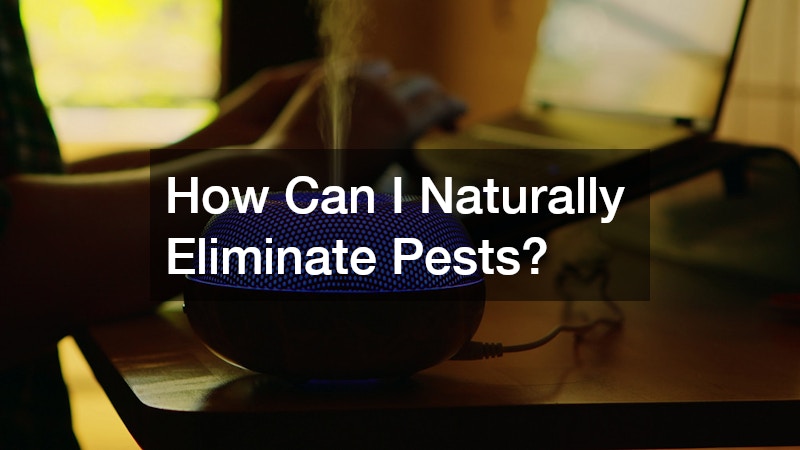
Utilizing Essential Oils
Essential oils are a natural and effective way to repel pests without relying on harsh chemicals. Oils such as peppermint, eucalyptus, and tea tree have strong scents that deter ants, spiders, and even rodents. Applying diluted essential oils around baseboards, window frames, and entry points can create a pest-free perimeter. For households with pets, essential oils must be used carefully to avoid toxicity, but when applied properly, they are a safe addition to natural pest control routines.
Essential oils complement structural improvements. Windows with well-sealed frames or garage doors that close snugly enhance the effectiveness of these oils by limiting pest entry. Some homeowners also incorporate window treatment services to reduce the chance of pests nesting near sunlight-exposed areas. By combining these approaches, essential oils can form part of a multi-layered strategy within local pest solutions.
Homemade Pest Control Solutions
Homemade pest control solutions offer budget-friendly, customizable options for homeowners. Mixtures of vinegar and water, or baking soda and sugar, can target ants and other common invaders. Garlic or onion sprays can repel mosquitoes, while diatomaceous earth sprinkled in strategic areas creates a barrier against crawling insects. Such solutions are particularly useful for minor infestations and as preventive measures.
Integrating these homemade remedies with broader home improvements maximizes their impact. For instance, while window contractors ensure windows are properly sealed, natural repellents add another line of defense. Garage door repairs can also complement DIY pest control by removing hidden access points. When combined with regular cleaning and preventive strategies, homemade solutions are a valuable tool in maintaining a pest-free home.
Are Professional Pest Control Services Worth It?
Evaluating the Need for Professionals
While DIY methods can address minor pest problems, severe infestations often require professional intervention. A local pest control company can provide expertise, specialized equipment, and safe, effective treatments. Professionals are trained to identify hidden infestations, assess the severity of a problem, and implement solutions that are both efficient and long-lasting.
Homeowners engaged in home construction, log home maintenance, or major renovations may find that professional pest control services are particularly valuable. Construction activities can disturb soil or materials, inadvertently attracting pests. Similarly, window contractors or garage door specialists may notice vulnerabilities that require professional pest management to prevent infestations.
What to Expect from a Professional Service
Professional pest control services typically begin with a thorough inspection of the property, identifying pest species, entry points, and areas of concern. Treatments vary depending on the type of pest, the level of infestation, and the home environment. Methods can include targeted chemical applications, baiting systems, or integrated pest management plans that combine multiple strategies.
For homeowners with pets, professional services often include guidance on pet safety and preventive measures to reduce exposure. Coordinating pest control efforts with window treatment services, garage door maintenance, and even pet boarding routines ensures a holistic approach. Utilizing professional expertise alongside DIY and natural solutions provides the most comprehensive local pest solutions.
How Can I Safely Use Pesticides?
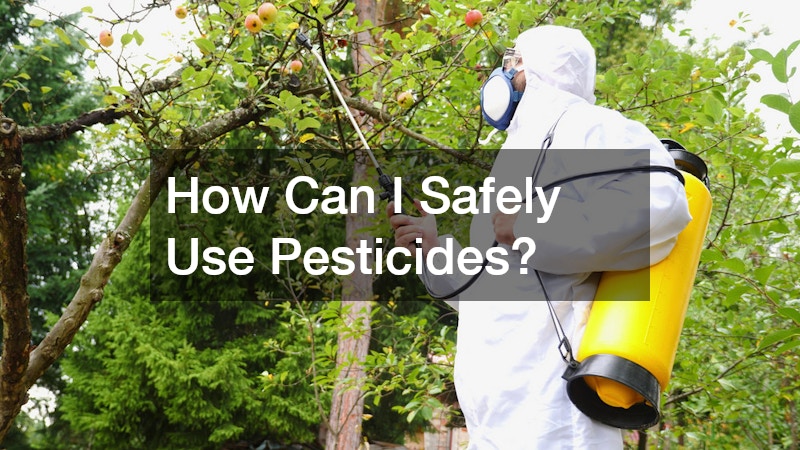
Understanding Pesticide Types
Pesticides are a common tool in managing pest populations, but understanding the different types and their uses is essential for safety and effectiveness. There are contact pesticides, which kill pests on direct contact; residual pesticides, which remain active for an extended period; and systemic pesticides, which are absorbed by plants to target pests feeding on them. Selecting the right type depends on the pest, the location of the infestation, and potential exposure to humans and pets.
Homeowners involved in home construction, or working with window contractors or garage door specialists, should be especially mindful of pesticide selection. Improper use can damage materials, finishes, or landscaping. A local pest control company can provide guidance, ensuring treatments are both effective and safe. Combining pesticide use with natural remedies, sealing entry points, and proper log home maintenance creates a multi-layered approach to local pest solutions.
Safety Precautions When Using Pesticides
Using pesticides safely is crucial to protect your family, pets, and property. Always read labels and follow manufacturer instructions regarding application rates, timing, and personal protective equipment. Keep children and pets away from treated areas until it is safe to re-enter. Ventilate indoor spaces to minimize inhalation risks and dispose of leftover chemicals properly.
Pest management also intersects with other home services. For instance, ensuring garage doors close tightly and windows are well-sealed helps reduce pesticide drift and exposure. For pet owners using pet boarding services, extra care should be taken to prevent accidental exposure. Following these precautions ensures that pesticides serve as a helpful tool rather than a hazard, complementing other local pest solutions.
What Are the Signs of a Pest Infestation?
Physical Signs of Infestation
Recognizing early signs of a pest infestation is key to swift intervention. Common indicators include droppings, chewed wires or furniture, gnaw marks, nests, and unusual odors. Insects like cockroaches often leave shed skins or egg cases, while rodents may create burrows or leave small holes in walls. Even small signs should not be ignored, as pests reproduce quickly and can cause significant damage in a short time.
Regular inspections, including monitoring window frames, garage doors, and log home structures, help detect these signs early. Window contractors or garage door specialists may notice gaps or damage that indicate potential entry points. Combined with professional consultation from a local pest control company, recognizing physical signs ensures timely, effective action in local pest solutions.
Behavioral Indicators to Watch For
Behavioral changes in pets or household members can also indicate the presence of pests. Pets may scratch excessively, become restless, or avoid certain areas of the home. Humans may experience unexplained bites, rashes, or allergy flare-ups. Even subtle changes in the way pets interact with their environment can provide clues.
Pet boarding facilities require particular attention, as pests can spread through kennels, cages, or bedding. Monitoring behavioral indicators in both pets and humans complements other preventive measures like sealing entry points, maintaining garage doors, or implementing window treatment services. Being attentive to these signs enhances the effectiveness of local pest solutions.
How Do Seasonal Changes Affect Pest Activity?
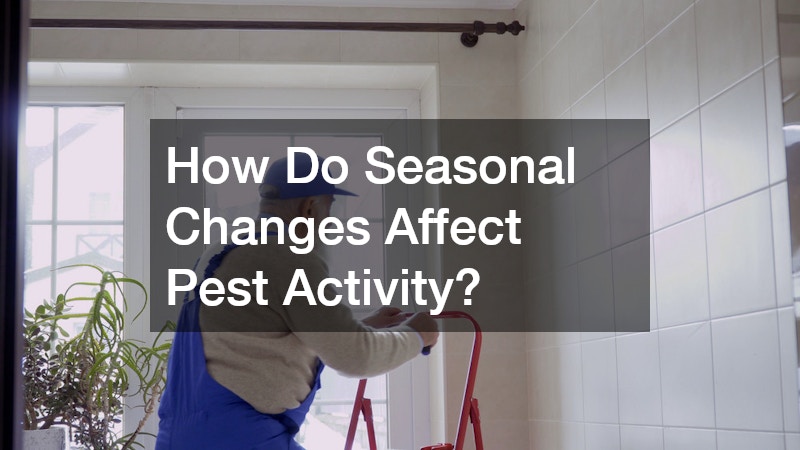
Common Seasonal Pests
Pest activity fluctuates with the seasons. Spring and summer often bring ants, flies, mosquitoes, and termites, while fall and winter can see rodents seeking warmth indoors. Seasonal pests are attracted by food, water, and shelter, all of which may be more accessible during certain times of the year. Understanding these patterns helps homeowners anticipate problems and implement preventive measures proactively.
Home construction timing and home renovations can also influence seasonal pest exposure. For example, installing new windows or garage doors in spring may inadvertently disturb nesting areas or expose entry points. Working with window contractors, local roofers, and a local pest control company ensures that seasonal pest activity is managed effectively as part of a holistic approach to local pest solutions.
Preparing Your Home for Seasonal Pest Issues
Adapting your home maintenance routine to seasonal changes is crucial for preventing infestations. Inspect and repair window seals, ensure garage doors close properly, and maintain roof integrity to reduce entry points. Outdoor debris, standing water, and overgrown vegetation should be addressed, as these attract pests like mosquitoes and rodents. Regular cleaning and proactive treatment can reduce risks throughout the year.
Log home maintenance requires particular attention during seasonal transitions, as natural wood gaps can expand or contract, creating vulnerabilities. Seasonal preparation also applies to pet boarding practices, ensuring that kennels and cages are free of pests. By anticipating seasonal changes, homeowners can stay ahead of infestations and maintain a safer, healthier home through comprehensive local pest solutions.
What Resources Are Available for Local Pest Solutions?
Local Pest Control Contacts and Organizations
Finding reliable local pest control services is a key component of effective home protection. Local pest control companies offer expertise, equipment, and treatment plans tailored to your home and neighborhood. Community organizations or municipal programs may also provide resources, guidance, or subsidized services for pest management.
Homeowners should integrate these services with other home maintenance activities. Window contractors, garage door specialists, and local roofers can help identify problem areas that may require professional pest treatment. Using these combined resources creates a network of protection that maximizes the impact of local pest solutions.
Online Resources and Tools
The internet offers a wealth of information for homeowners seeking guidance on pest prevention and control. Educational websites, DIY tutorials, and online tools allow homeowners to identify pests, track infestations, and implement preventive measures. Forums and review sites can help locate reputable local pest control companies and evaluate services.
In addition, online guides often cover complementary topics such as window treatment services, garage door maintenance, and pet boarding tips to reduce pest exposure. By leveraging both professional services and digital resources, homeowners can access a comprehensive toolkit for implementing effective local pest solutions throughout their property.
Maintaining a safe and healthy home requires a combination of preventive practices, natural remedies, and professional support. By understanding common pests, their risks, and the signs of infestation, homeowners can take proactive steps to protect their property. Routine cleaning, sealing entry points, and seasonal preparations form the foundation of effective pest control, while natural solutions like essential oils and homemade remedies provide additional defense.
Professional intervention from a local pest control company is invaluable for severe infestations or when preventive measures alone are insufficient. Integrating pest control with home improvements—such as window contractors, window treatment services, garage doors, and log home maintenance—ensures that every aspect of the home contributes to a pest-resistant environment. Even pet boarding practices should be aligned with pest prevention strategies to maintain a safe household. By utilizing these local pest solutions and resources, homeowners can create a consistently safe, healthy, and comfortable living space for themselves, their families, and their pets.
